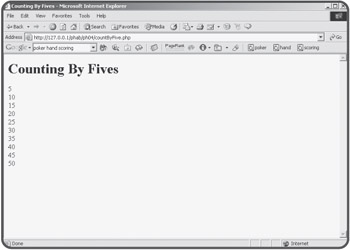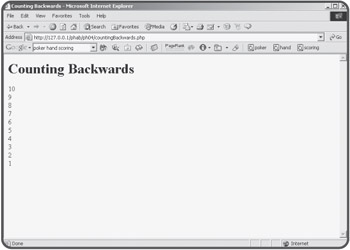Modifying the for Loop
Modifying the for Loop
Once you understand the basics of the for loop structure, you can modify it in a couple of interesting ways. You can build a loop that counts by fives, or one that counts backwards.
Counting by Fives
The countByFive.php program shown in Figure 4.4 illustrates a program that counts by fives.

Figure 4.4: This program uses a for loop to count by five.
The program is very much like the basicArray program, but with a couple of twists.
<html>
<head>
<title>
Counting By Fives
</title>
</head>
<body>
<h1>Counting By Fives</h1>
<?
for ($i = 5; $i <= 50; $i+= 5){
print "$i <br>\n";
} // end for loop
?>
</body>
</html>
The only thing I changed was the various parameters in the for statement. Since it seems silly to start counting at 0, I set the initial value of $i to 5. I decided to stop when $i reached 50 (after ten iterations). Each time through the loop, $i will be incremented by 5. The += syntax is used to increment a variable.
$i += 5;
is exactly like
$i = $i + 5;
Counting Backwards
It is fairly simple to modify a for loop so it counts backwards. Figure 4.5 illustrates this feat.

Figure 4.5: This program counts backwards from ten to one using a for loop.
Once again, the basic structure is just like the basic for loop program, but by changing the parameters of the for structure I was able to alter the behavior of the program. The code for this program shows how it is done.
<html>
<head>
<title>
Counting Backwards
</title>
</head>
<body>
<h1>Counting Backwards</h1>
<?
for ($i = 10; $i > 0; $i--){
print "$i <br>\n";
} // end for loop
?>
</body>
</html>
If you understand how for loops work, the changes will all make sense. I'm counting backwards this time, so $i begins with a large value (in this case 10.) The condition for continuing the loop is now $i > 0, which means the loop will continue as long as $i is greater than zero. As soon as $i is zero or less, the loop will end. Note that rather than adding a value to $i, this time I decrement by one each time through the loop. If you're counting backwards, you must be very careful that the sentry variable has a mechanism for getting smaller, or the loop will never end. Recall that $i++ adds one to $i. $i- - subtracts one from $i.







